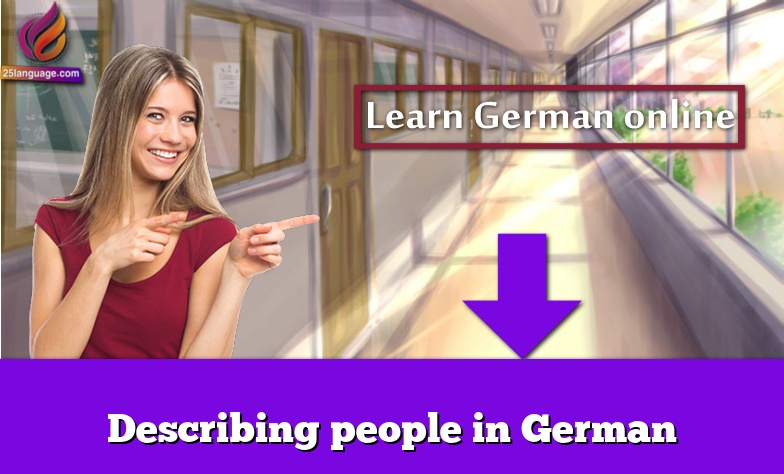Describing people in German

Today lesson is about Describing people in German.
I can’t describe in words how important this section of the lesson is. Even though you have already learned to describe to some degree, here we will introduce a new aspect of describing, and we will review.
But how could we describe if we didn’t have vocabulary? Here it is…
| English | German |
| nice | nett, sympathisch |
| mean | unfreundlich, gemein |
| nasty | fies, gemein |
| pretty | schön |
| ugly | hässlich |
| intellegent | intelligent |
| clever | schlau, klug, clever |
| stupid | dumm/blöd/deppert (Austrian German) |
| interesting | interessant |
| boring | langweilig, fad |
| active | rührig, aktiv |
| lazy | faul |
| funny | komisch, witzig |
| serious | ernst(haft) |
| strong | stark, kräftig |
| weak | schwach |
| odd | eigenartig |
| talented | begabt, talentiert |
| untalented | unbegabt, untalentiert |
| bossy | rechthaberisch |
| passive | untätig |
| old | alt |
| young | jung |
| fat | fett, dick |
| skinny | dünn |
| tall | groß |
| short | klein |
| evil | böse |
The verb used most often for describing is “to be” which we learned in the first lesson. Some examples are: He is wet, This is stupid, I am lazy. But you do use other verbs like feel, look, etc. This lesson we will be sticking mostly with the verbs we’ve learned in the past. We will, however, learn one new verb. All sentences we will create will be in the nominative case. Okay, let’s get started!
In term of beauty, you can say four basic things. These aren’t the all but these are the easiest and simplest ones.
She is beautiful.
Sie ist schön.
He is ugly.
Er ist hässlich.
These two use the verb to be, and the next one will use the verb to look which would need something else in order to make sense.
She looks beautiful, but that shirt is ugly.
Sie sieht schön aus, aber dieses Hemd ist hässlich.
He looks ugly, but he looked handsome yesterday.
Er sieht hässlich aus, aber gestern sah er schön aus.
And in the last sentence it says “ausgesehen.” Don’t worry about that–it wouldn’t be taught until Level 3. So since you get the idea of describing, let’s learn a new verb! And the new verb is klingen which is to sound. As in “He sounds weird.”, “She sounds boring.” Since we know how to describe, we really don’t have to cover it. It’s works just like other verbs.
He sounds nice.
Er klingt nett.
They sound funny.
Sie klingen komisch.
Remember that when describing it’s S+V+A, or subject, verb, then adjective. Exactly like in English. For right now, that’s all for describing things. We are going to have some small describing lessons with some parts of this lesson.
Related Verbs
Okay we just went over the verb in the previous section. This will basically be a list that will help you memorize them better, and there is not a lot. Other than “klingen” and “fühlen” you should know all of these. The “Er sieht aus” is to show you it is a separable-prefix verb.
| English | German |
| To be | sein |
| To look | aussehen, ausschauen (Austrian German) |
| He looks | Er sieht aus |
| To feel | (sich) fühlen |
| To sound | klingen |





























